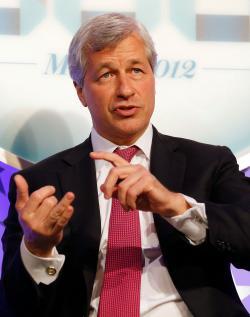What to do with Jamie Dimon? The CEO and Chair of JPMorgan Chase has tried so hard in the past several years to seem the “good banker.” He is so charming and gracious, yet all the while lobbying, cajoling, pushing, and wheedling to eviscerate any semblance of real reform on Wall Street. He shrugged off the cataclysm of 2008 as just something that happened, like the weather—no need for any structural reform.
Now the chickens have come home to roost—at least 2 billion of them—and it is clear that Chase is like every other big financial institution with distorted incentives. Thanks to a backstop of a federal guarantee, these gigantic institutions get to keep all the upside of crazy bets while the government gives them all the downside protection they need. Earlier this year, Dimon pooh-poohed concerns about the risks his traders were taking. Did Dimon not understand those risks, not care to know about them, or actually mislead the public about them?
But it isn’t so much money, they cry! True, in the context of Chase’s balance sheet, a $2 billion loss can be absorbed. But it shows once again the impossibility of trusting the banks in the absence of structural reform and regulation to control their willingness to take almost unmitigated risk. Of greater significance than the size relative to Chase’s balance sheet is that the loss was in a relatively stable market in which most people are finding it easy to trade. Imagine if the market had been choppy—the losses could have been even more gargantuan—and if several institutions had been in the same position, then the aggregate effect could have become once again cataclysmic.
It was Chase’s own lobbying on Capitol Hill and with the Treasury, the Fed, and other agencies that made these bets arguably permissible within the scope of hedging under the Volcker rule. Had they not lobbied and pushed and delayed and made the rule more complicated, these bets would have been illegal or at a minimum so transparent as to have been smaller and less damaging. The banks love to complain about the complexity of these rules. But the rule as proposed by Paul Volcker was simple. It is only because of the very lobbying by the banks that the complexity and loopholes crept in.
The structural solution is not complicated, and it is something close to what was proposed by a conservative banker from the Midwest last week. Warren Stephens, CEO of the Stephens Bank, argues that we should slim down “too big to fail” institutions by a significant factor, reducing their deposits and assets as a percentage of GDP to a more manageable 5 percent from the existing 10 percent—and bring back Glass-Steagall, which separated commercial from investment banking. That way taxpayers would guarantee only what should be guaranteed: deposits and basic lending.
But none of this answers the question what to do with Dimon himself. Most folks would be surprised to find out that he sits on the board of the New York Federal Reserve Bank—the very organization that is supposed to oversee his bank’s financial practices, the organization that is supposed to issue all sorts of regulations that control what his bank can do, the very organization he has been lobbying to relax the rules about the bets he wants to make.
So here is a modest solution: Dimon should resign from the New York Fed board immediately, acknowledging that his role is incompatible with what he has been trying to do in terms of lobbying and his abject failure as a manager to control risk within his own organization.
The Fed conflict is so obvious that it defies any possible rationalization or explanation. For a decade, the New York Fed has failed to pick up on any of the significant Wall Street threats: excess leverage, subprime fraud, dangerous concentration in “too big to fail” entities. Maybe the reason is that the board is controlled by the very voices that have been at the root of the failure. There has been not the slightest voice of protest from the board—yet it is a public organization!
If Dimon fails to resign from the New York Fed, there should be a public outcry demanding his resignation. Maybe Occupy Wall Street can make this a tangible demand for a new series of protests. Maybe elected officials can demand that the New York Fed reveal what role Chase and Dimon have played in any of the body’s internal decisions. Having the chairman and CEO of Chase on the board of the New York Fed highlights the severe structural problems we still have in our financial system. Enough is enough.
